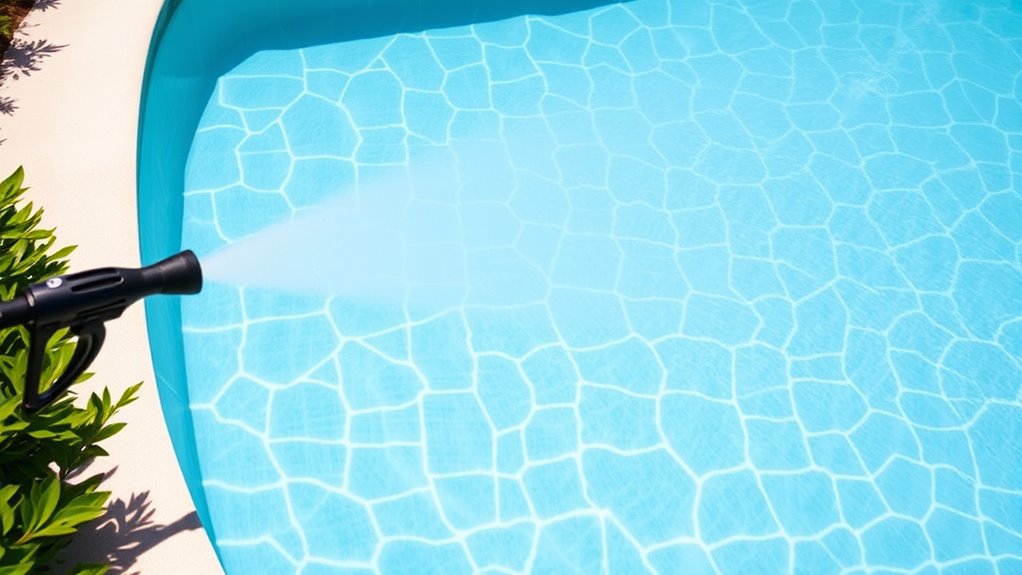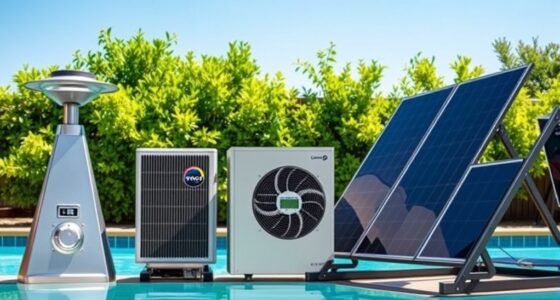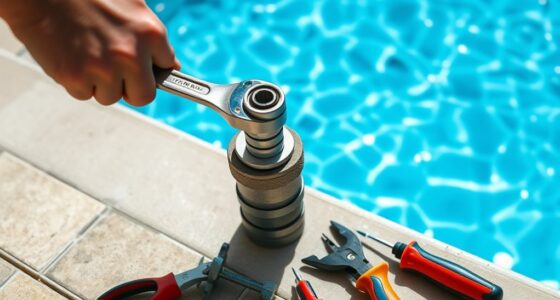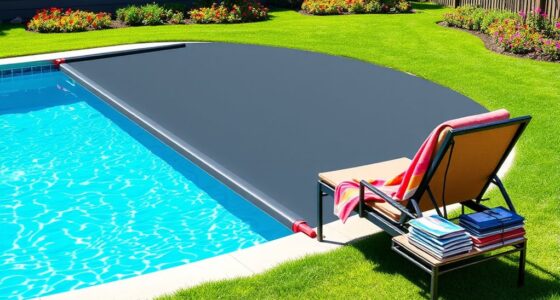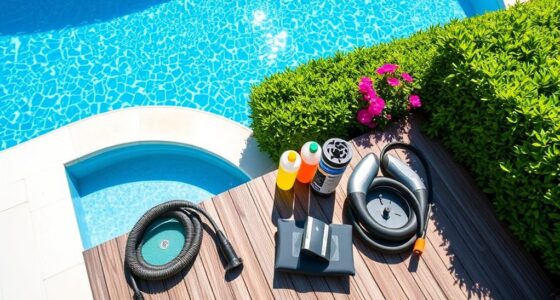To keep your pool surfaces stain-free, regularly test and adjust your water chemistry, maintaining proper pH levels and adding sequestering agents if needed. Use the right tools like skimmers, brushes, and vacuums to remove debris and prevent algae growth. Address stains early with targeted cleaners for mineral or metal deposits, and follow preventative measures like cover maintenance and debris control. For more tips on effective cleaning and stain prevention, you’ll find useful strategies as you continue.
Key Takeaways
- Regularly test and balance water chemistry, especially pH levels, to prevent chemical reactions causing stains.
- Use appropriate cleaning tools like brushes, skimmers, and vacuums for routine surface maintenance.
- Address organic stains promptly with skimming, brushing, and algae removers to prevent deeper staining.
- Employ stain-specific treatments such as metal sequestrants and acid washes for mineral or metal stains.
- Follow safety guidelines, store chemicals properly, and maintain equipment to ensure effective and safe cleaning.
Understanding Common Pool Stains and Their Causes
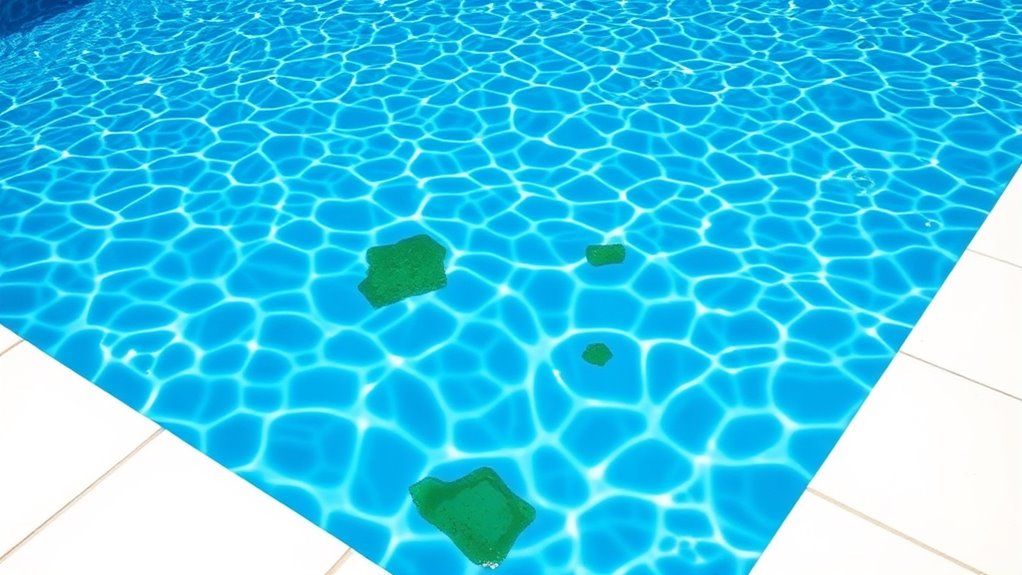
Many common pool stains have identifiable causes, making it easier for you to address and prevent them. Most stains result from chemical reactions that occur when the pool’s chemicals aren’t balanced properly. For example, when the pH balance is too high or too low, it can lead to mineral deposits or algae growth, which leave stubborn stains on your pool surfaces. Copper and iron can leach into the water from pool equipment or debris, creating blue or rust-colored marks. Understanding these causes helps you take proactive steps, like maintaining proper pH levels, to prevent stains from forming. Regular testing and adjusting your pool’s chemistry guarantees the water remains balanced, reducing the risk of staining and keeping your pool looking clean and inviting. Additionally, oxidation of metals can contribute to staining if metal levels are not properly controlled. Proper filtration and the use of sequestering agents can also help prevent mineral buildup, ensuring your pool remains pristine. Being aware of common staining agents and their effects can guide you in selecting appropriate cleaning methods and products. Maintaining water chemistry is essential to avoid the formation of stubborn stains and maintain a beautiful pool surface.
Gathering the Right Tools for Effective Cleaning
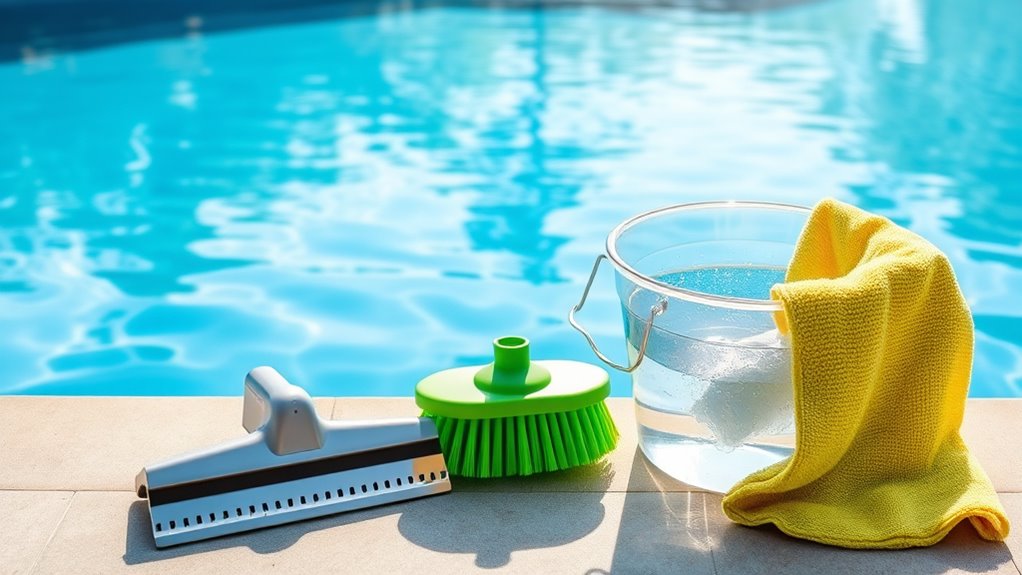
To clean your pool effectively, you need the right supplies, like brushes, skimmers, and pH testers. Make certain your tools are in good condition to prevent scratches and guarantee thorough cleaning. Keeping your equipment well-maintained helps you get the best results every time. Using appropriate cleaning tools ensures maximum efficiency and prevents unnecessary damage to your pool surfaces. Additionally, staying informed about data privacy challenges can help you choose the right equipment that safeguards your personal information. Regularly inspecting and upgrading your performance parts can also ensure your cleaning equipment operates at peak efficiency and longevity, especially when selecting products with effective exfoliating properties to maintain clear and healthy pool surfaces. Understanding Gold IRA rollovers can also provide insights into protecting your assets and diversifying your investments for long-term security.
Essential Cleaning Supplies
Having the right cleaning supplies on hand is essential for effectively maintaining your pool surfaces. Start with a good pool water testing kit to monitor chemical levels regularly. Proper chemical balancing prevents stains and algae buildup, making cleaning easier. You’ll also need a durable pool skimmer net to remove leaves and debris, along with scrub brushes or brushes with soft bristles for scrubbing surfaces without causing damage. A telescoping pole helps reach hard-to-access areas, while a vacuum or pool cleaner can handle stubborn dirt. Don’t forget to have cleaning gloves to protect your hands and a towel or cloth for quick wipe-downs. Using proper cleaning techniques can further improve your results and extend the life of your pool surfaces. Regular maintenance and timely cleaning are key to preventing stubborn stains and keeping your pool water clear. Incorporating preventive measures, such as regular brushing and chemical checks, can significantly reduce the need for intensive cleaning sessions. Additionally, understanding the importance of professional services can help ensure your pool remains in optimal condition. Employing high-quality cleaning tools and staying informed about water quality management can further protect your pool surfaces from damage and stains. These supplies ensure you can keep your pool in top condition, reducing stains and maintaining clear, inviting water.
Proper Tool Maintenance
Ensuring your cleaning tools are well-maintained is crucial for effective pool care. Proper tool maintenance prevents damage and keeps your equipment working efficiently. Regularly inspect your pool brush for wear and tear, and clean it after each use to maintain ideal brush performance. Store chemicals safely, following chemical storage safety guidelines to avoid spills or accidents. Keep your pool brush in a dry, clean place to prevent rust and mold. Additionally, check for loose bristles or broken parts that could scratch your pool surface. Proper maintenance extends the life of your tools and guarantees thorough cleaning. Using appropriate storage methods can help prevent corrosion and damage to your equipment. Incorporating proper cleaning techniques ensures your tools remain in optimal condition for every use. Maintaining AI safety measures is essential as AI becomes more integrated into operational processes. Remember, well-maintained tools make your pool surface look spotless and help prevent stains. Paying attention to pool surface care can significantly reduce the buildup of stains and debris. Taking these simple steps saves you time and money while keeping your pool in top shape.
Regular Skimming and Brushing Techniques
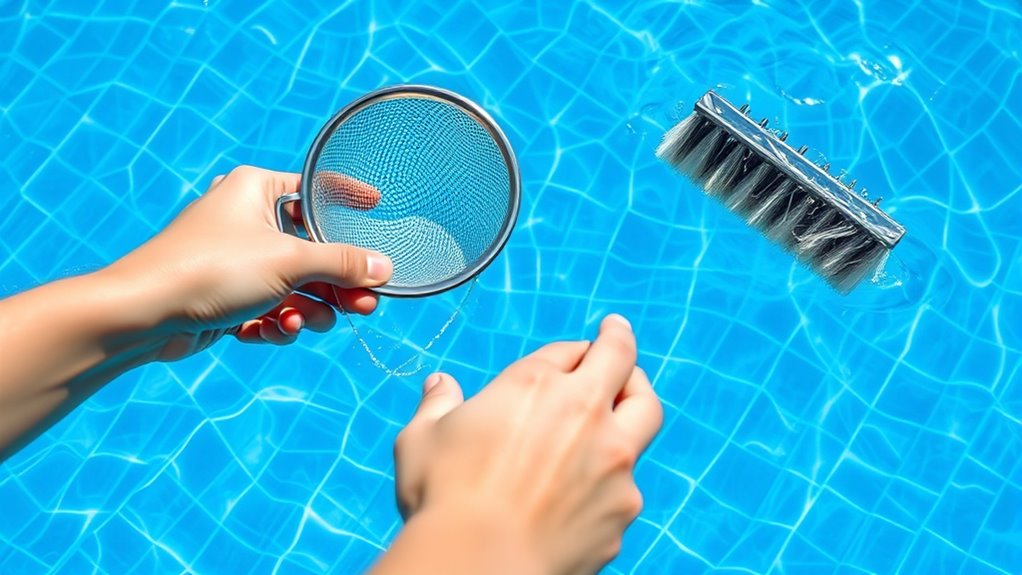
Regular skimming and brushing are essential for keeping your pool surfaces clean and clear. By removing leaves, insects, and debris daily, you prevent buildup that can promote pool algae growth. Skimming keeps the water surface free of floating debris, allowing for better water circulation and reducing stagnation. Brushing the walls and floor helps dislodge dirt and algae spores, making it easier for the filtration system to remove contaminants. Be sure to focus on areas where debris tends to accumulate, like corners and steps. Consistent maintenance ensures better water quality and prevents stains caused by organic matter. Additionally, using proper pool surface materials and understanding their properties can help in selecting the right cleaning tools and techniques. Proper skimming techniques enhance debris removal efficiency, saving you time and effort. Regular maintenance also helps in managing organic matter that can cause staining and cloudiness in your pool water. Incorporating air purifiers into your indoor space can further improve air quality, creating a healthier environment around your pool area. Regular cleaning routines can also be complemented by understanding the retail hours of your nearby stores to ensure you can easily pick up necessary supplies without inconvenience. With regular skimming and brushing, you’ll maintain a healthier, more inviting pool while reducing the need for harsh chemical treatments.
How to Remove Organic Stains and Debris
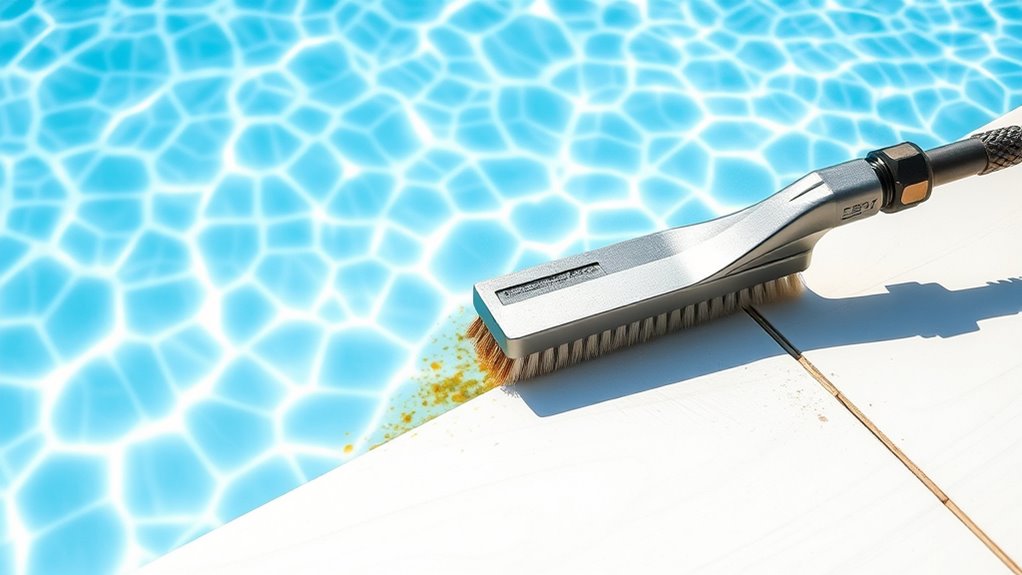
Organic stains and debris can quickly mar the appearance of your pool if not addressed promptly. They often result from leaves, dirt, and organic debris that settle on the surface, encouraging algae buildup. To remove these issues, start by skimming the surface with a leaf net or skimmer to eliminate floating debris. Then, brush the pool walls and floor to loosen organic stains and algae. Consider using a pool algae remover or a mild chlorine shock treatment to break down organic debris and prevent further buildup. Regularly checking and maintaining proper water chemistry also helps inhibit algae growth. Additionally, using an effective water filtration system can enhance debris removal and improve overall water clarity.
- Use a pool brush to scrub algae spots and stains
- Shock your pool weekly to control organic debris
- Keep skimming tools handy for quick cleanups
Addressing Metal and Mineral Stains
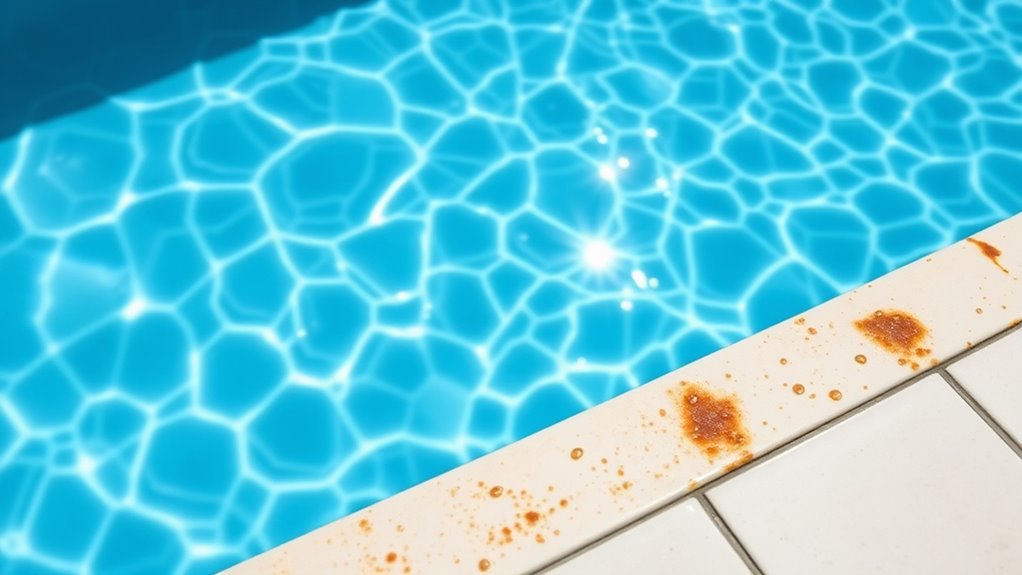
Metal and mineral stains can be tricky to recognize and eliminate, but knowing what to look for makes a difference. You might notice reddish, greenish, or brownish marks on your pool surfaces, indicating specific stains. Using the right methods and products guarantees you effectively restore your pool’s appearance without damaging the surfaces. Identifying the types of stains that suit your pool can also help in selecting the appropriate cleaning techniques and products, ensuring long-lasting results.
Identifying Common Stains
Metal and mineral stains are common issues that can quickly tarnish the clarity of your pool surfaces. To tackle them effectively, you need good stain identification and surface analysis skills. Look closely at your pool surface—color, shape, and location can give clues about the stain type.
For example,:
- Reddish-brown stains often signal metal deposits like iron or copper.
- Greenish or bluish stains may indicate copper buildup.
- White or cloudy deposits are usually mineral scale from calcium or other minerals.
Effective Removal Methods
To effectively remove metal and mineral stains from your pool surfaces, it is vital to choose the right cleaning methods tailored to each stain type. For metal stains, use a metal sequestrant to bind the metals and prevent further staining, then scrub affected areas with a stain remover designed for metal deposits. Mineral stains, often caused by calcium or other minerals, respond well to an acid wash or a specialized scale remover. Regularly monitoring your water chemistry and adjusting your cleaning frequency helps prevent these stains from setting in. For persistent stains, a combination of chemical treatments and mechanical scrubbing is often necessary. Always follow product instructions carefully to avoid damaging your pool surface. Properly addressing pool stain types ensures your pool stays clean, clear, and stain-free.
Using Pool Cleaners and Stain Removers Safely
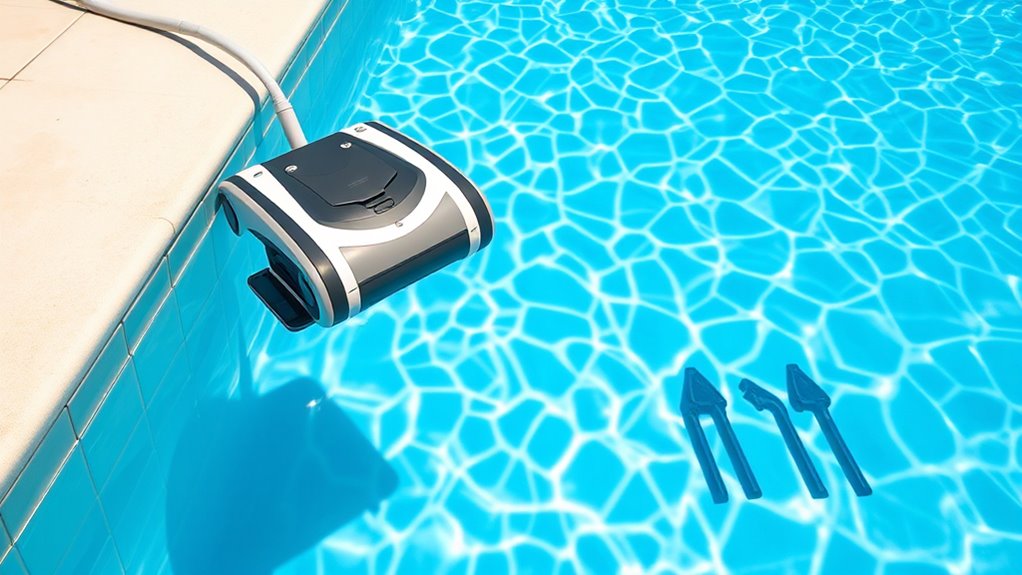
When using pool cleaners and stain removers, it is vital to follow safety guidelines to prevent accidents and damage. Always read labels carefully and wear protective gear like gloves and goggles. Make sure proper ventilation if working indoors, and store chemicals out of children’s reach. Use eco-friendly cleaning options when possible to protect your pool environment and avoid harsh chemicals that could harm your skin or eyes. Keep pool chemical safety in mind by handling substances responsibly, and never mix different chemicals. Regularly maintain your equipment to prevent leaks or spills. Remember, safe use not only preserves your pool’s surface but also keeps everyone safe while enjoying a clean, beautiful pool.
Follow safety guidelines: wear protective gear, store chemicals properly, and choose eco-friendly products for a safe, beautiful pool.
- Wear protective gear and follow instructions
- Store chemicals safely, out of children’s reach
- Opt for eco-friendly cleaning products
Preventative Measures to Keep Stains at Bay
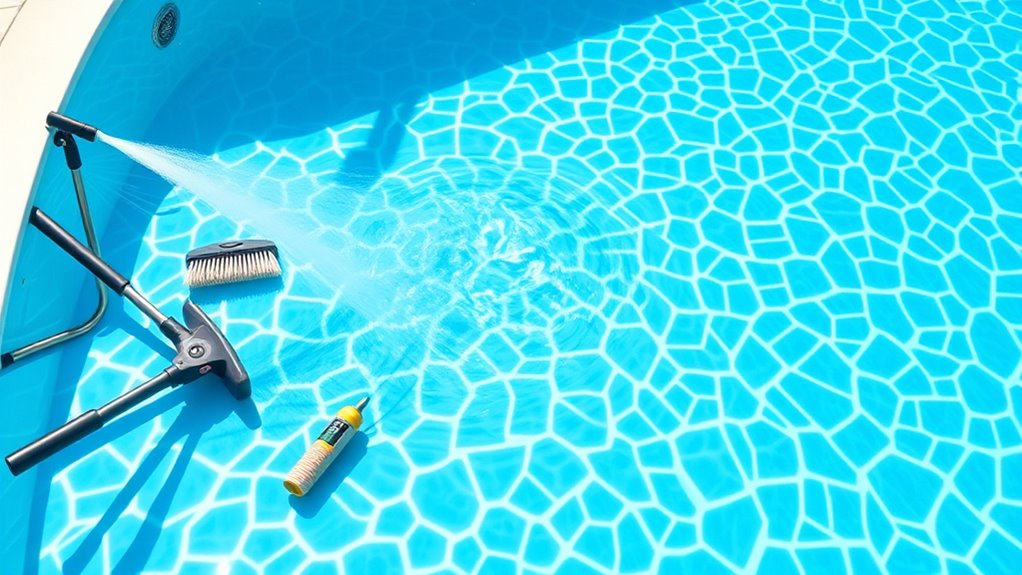
Maintaining your pool’s appearance starts with proactive steps to prevent stains before they form. Regular pool cover maintenance is essential—clean and dry your cover frequently to stop dirt, leaves, and algae from transferring into the water. Using a quality cover also minimizes debris buildup. Additionally, applying algae prevention techniques, like brushing the pool walls and using algaecides as recommended, keeps algae growth in check. Keep an eye on water runoff and avoid leaving the pool uncovered during storms or heavy winds, which can introduce contaminants. Properly managing these preventative measures reduces the risk of stains caused by organic matter and algae. Consistent upkeep ensures your pool stays clean and inviting, saving you time and effort on deeper cleaning later.
Maintaining Proper Water Chemistry
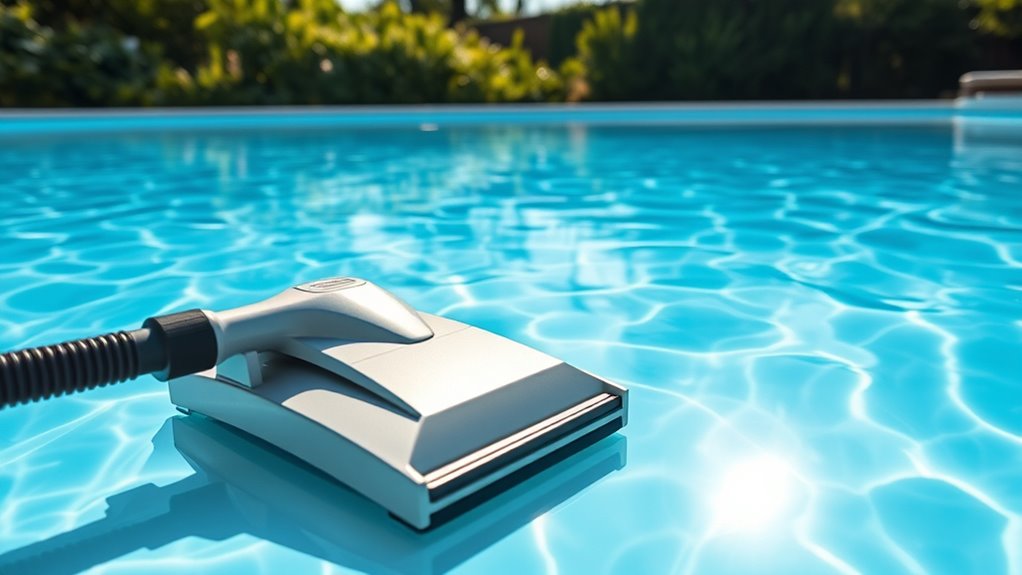
Ensuring your pool’s water chemistry stays balanced is essential for preventing stains and maintaining clear, inviting water. Proper chemical balancing, especially pH balancing, keeps minerals from settling on surfaces and reduces algae growth. When your pH is off, it can lead to cloudy water and staining, so regular testing is key.
Maintaining balanced water chemistry prevents stains and keeps your pool sparkling clear.
To keep things on track, consider:
- Testing your water weekly to catch discrepancies early
- Using pH adjusters to maintain a steady level between 7.2 and 7.6
- Regularly adding appropriate chemicals to optimize chemical balancing
Staying proactive with your water chemistry will protect your pool surfaces and keep your swimming experience spotless and enjoyable.
Tips for Cleaning Different Pool Surfaces
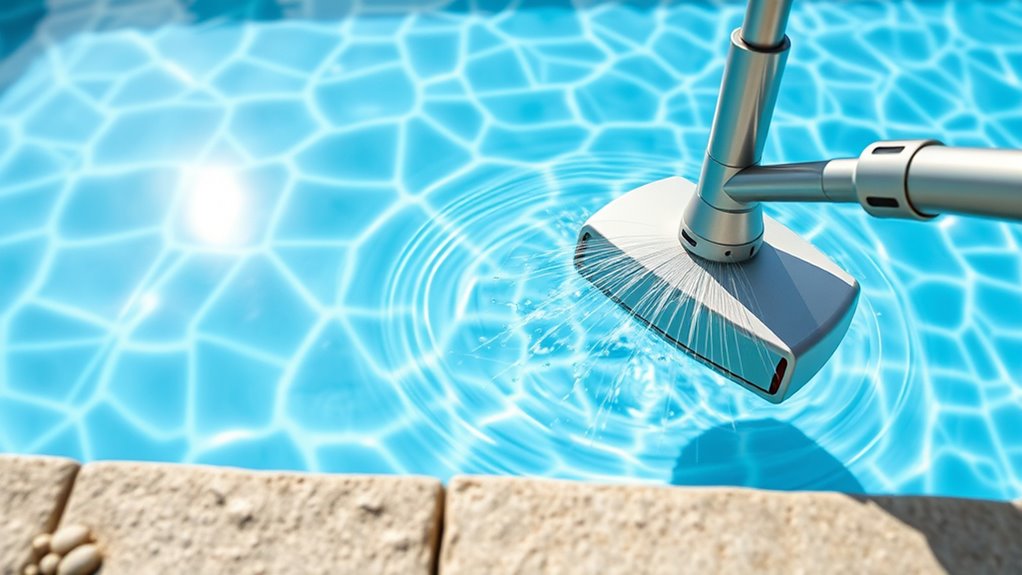
Different pool surfaces require specific cleaning techniques to keep them looking their best. Understanding your pool’s surface textures helps you choose the right cleaning tools and methods. For example, smooth surfaces like acrylic or fiberglass are easier to scrub without damage, while textured surfaces such as pebble or plaster may need gentle brushing to prevent abrasion. Proper stain identification is key; recognize common stains like algae, calcium, or rust, so you can select appropriate cleaners. Regularly inspect your pool for early signs of staining or buildup, and adjust your cleaning routine accordingly. Using the correct tools and cleaning solutions tailored to your pool’s surface will help maintain its appearance and longevity, keeping your pool inviting and stain-free.
When to Seek Professional Help for Stain Removal
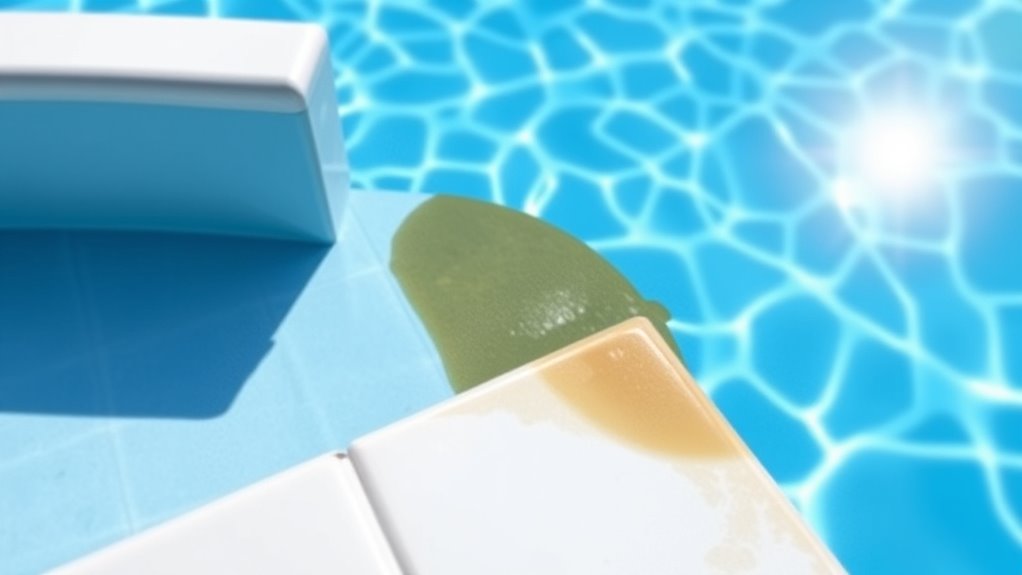
While some stains can be safely treated with DIY methods, you should consider seeking professional help when stains persist despite your efforts or worsen over time. Pool stain detection can be tricky, especially if stains are deep or widespread. If you notice stubborn discoloration that doesn’t respond to cleaning or chemical treatments, it’s time to call in experts for professional stain removal. Also, if stains start spreading or the pool’s appearance deteriorates, delaying professional intervention can lead to more costly repairs. Recognize when DIY isn’t enough, and trust professionals to assess and treat the problem effectively. Remember, timely professional help ensures your pool looks its best and stays safe for swimming. Don’t hesitate to seek expert advice when in doubt.
Frequently Asked Questions
Can Homemade Solutions Effectively Remove All Types of Pool Stains?
You might wonder if DIY remedies can fully remove all pool stains. While homemade solutions can tackle common stains like algae or dirt, they may not be effective against tougher or mineral-based stains. Chemical alternatives often work better for stubborn spots. It’s best to identify the stain type first, then choose appropriate DIY remedies or professional treatments to guarantee your pool stays clean and clear.
How Often Should I Deep Clean My Pool to Prevent Stains?
You should deep clean your pool regularly to keep it pristine, prevent stains, and maintain proper pool maintenance. Aim for a thorough cleaning every 4 to 6 months, or more often if you notice buildup or staining. Regular brushing, vacuuming, and skimming help prevent stains from settling in. By staying consistent with your pool maintenance routine, you guarantee a clean, clear, and inviting swimming environment, free from unsightly stains.
Are There Eco-Friendly Cleaning Options for Stubborn Stains?
If you’re looking for eco-friendly options for stubborn stains, consider biodegradable cleaners and natural stain removers. You can use vinegar, baking soda, or eco-friendly commercial products that break down safely in the environment. These options are effective at tackling stains without harsh chemicals, helping keep your pool clean and green. Regular use of natural solutions can prevent buildup, making stain removal easier and more sustainable for your pool.
How Do Weather Changes Influence Stain Formation and Removal?
You might think weather changes won’t affect stain removal, but they do. Weather patterns, like rain or heat, influence stain severity by causing minerals to settle or accelerate algae growth. Cooler weather can slow down stain formation, but sudden temperature shifts can make stains harder to remove later. To keep your pool surface clean, adjust your cleaning schedule based on these weather fluctuations, ensuring stains don’t become more stubborn over time.
What Are Signs That Stains Are Causing Damage to Pool Surfaces?
You’ll notice signs that stains are damaging your pool surfaces through discoloration and uneven stain color indicators. These stains can lead to pool surface deterioration over time if left untreated. Look for peeling, cracking, or rough patches as physical signs of damage. If stains become more prominent or change in appearance, it’s a clear sign you need to act quickly to prevent further deterioration and preserve your pool’s integrity.
Conclusion
With regular maintenance and quick action, you can keep your pool spotless and stain-free. Remember, an ounce of prevention is worth a pound of cure—staying on top of water chemistry and cleaning routines makes all the difference. Don’t wait for stains to take over; tackle issues early, and your pool will stay inviting and beautiful all season long. Keep up the effort, and you’ll enjoy crystal-clear waters without the hassle.

